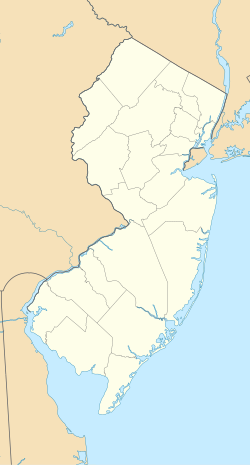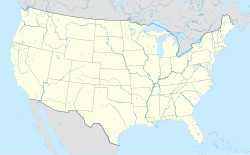Jugtown Historic District: Difference between revisions
| Line 43: | Line 43: | ||
In 1766, a potter named John Morton, from [[Wrightstown Township, Bucks County, Pennsylvania|Wrightstown, Pennsylvania]], bought a lot from Horner and established a pottery southwest of the crossroads. By 1789, production of jugs in the village was substantial enough to give the community its name.<ref name=":4" /> Both British and [[Continental Army|Patriot]] soldiers were housed in the village during the [[American Revolutionary War]], as were delegates to the [[Continental Congress]] in 1783.<ref name=":6" /> A number of slaves were present in the community, owned by residents such as Joseph Horner and John Harrison. A stop on the [[Underground Railroad]] existed in the village, with an underground tunnel under Nassau Street connecting the Horner house to the home owned by Esther Johnson.<ref>Zink, pp. 6-7</ref> |
In 1766, a potter named John Morton, from [[Wrightstown Township, Bucks County, Pennsylvania|Wrightstown, Pennsylvania]], bought a lot from Horner and established a pottery southwest of the crossroads. By 1789, production of jugs in the village was substantial enough to give the community its name.<ref name=":4" /> Both British and [[Continental Army|Patriot]] soldiers were housed in the village during the [[American Revolutionary War]], as were delegates to the [[Continental Congress]] in 1783.<ref name=":6" /> A number of slaves were present in the community, owned by residents such as Joseph Horner and John Harrison. A stop on the [[Underground Railroad]] existed in the village, with an underground tunnel under Nassau Street connecting the Horner house to the home owned by Esther Johnson.<ref>Zink, pp. 6-7</ref> |
||
The early 19th century saw the first accounts of new commercial activity in Jugtown. By 1803, a brickyard and pipe factory was being operated by Stephen Scales. Around this time, Jacob Ineka had opened a second pottery south of Nassau Street,<ref name=":7" /> with the original pottery possibly having been shut down.<ref name=":8">Craig, p. 9</ref> Jugtown produced stone and clay jugs, with one of the village's potters known to have been [[African Americans|African-American]].<ref name=":7">Zink, p. 8</ref> Jugtown, previously divided between the townships of [[West Windsor, New Jersey|West Windsor]] and [[Montgomery Township, New Jersey|Montgomery]],<ref name=":1" /> became part of [[Borough of Princeton, New Jersey|Princeton Borough]] in 1813, though it retained an independent identity. Trade on the [[Delaware and Raritan Canal]] led to a period of economic prosperity that contributed to Jugtown's growth in the 1830s. A hotel existed in the community by the end of the decade.<ref name=":8" /> |
The early 19th century saw the first accounts of new commercial activity in Jugtown. By 1803, a brickyard and pipe factory was being operated by Stephen Scales. Around this time, Jacob Ineka had opened a second pottery south of Nassau Street,<ref name=":7" /> with the original pottery possibly having been shut down.<ref name=":8">Craig, p. 9</ref> Jugtown produced stone and clay jugs, with one of the village's potters known to have been [[African Americans|African-American]].<ref name=":7">Zink, p. 8</ref> Jugtown, previously divided between the townships of [[West Windsor, New Jersey|West Windsor]] and [[Montgomery Township, New Jersey|Montgomery]],<ref name=":1" /> became part of [[Borough of Princeton, New Jersey|Princeton Borough]] in 1813, though it retained an independent identity. Trade on the [[Delaware and Raritan Canal]] led to a period of economic prosperity that contributed to Jugtown's growth in the 1830s. A hotel existed in the community by the end of the decade.<ref name=":8" /> |
||
A Presbyterian Chapel seating about 200 that later served as a school was built on a Harrison Street lot donated in 1832 by John C. Schenk, who operated a second general store at 341 Nassau Street.<ref name=":9">Zink, pp. 12-13</ref> A tavern existed at 343-345 from about 1830, with the building housing a general store from the mid-1840s.<ref>Zink, pp. 24-25</ref> Silkworms were raised in the village in the mid-1830s, which also housed a carriage shop.<ref name=":1" /> In the mid-19th century, the village also traded in pork and produce.<ref name=":8" /> An 1852 map shows the south side of Nassau Street densely lined with houses.<ref name=":8" /> |
|||
An 1852 map shows the south side of Nassau Street densely lined with houses.<ref name=":8" /> |
|||
=== Industrial decline and women's college (1852-1897) === |
|||
Around mid-century, growing ceramics competition from Trenton caused many of Jugtown's potteries to close.<ref name=":7" /><ref name=":10">Craig, p. 10 |
|||
</ref> In the late 19th century, Jugtown expanded southwards to encompass the space up to Prospect Street. During this period, Jugtown's industry slowly disappeared, although it retained a residential and commercial character.<ref name=":10" /> Princeton Fire Engine Company No. 1 operated in a Nassau Street building in Jugtown until about 1880, at which time the prominent local Margerum family adapted the building, as well as a few others, into houses.<ref name=":9" /><ref name=":10" /> Stephen Margerum also owned an ice company |
|||
== Works cited == |
== Works cited == |
||
Revision as of 15:46, 21 October 2024
Jugtown Historic District | |
| Location | Portions of Nassau and Harrison streets; Evelyn Place |
|---|---|
| Coordinates | 40°21′14.2″N 74°38′44.0″W / 40.353944°N 74.645556°W |
| Area | 15 acres (6.1 ha) |
| Built | 18th century - c. 1918 |
| Architect | Multiple |
| Architectural style | Queen Anne, Shingle Style |
| NRHP reference No. | 86003670 |
| NJRHP No. | 1737[1] |
| Significant dates | |
| Added to NRHP | January 22, 1987 |
| Designated NJRHP | December 16, 1986 |
The Jugtown Historic District consists of a cluster of historic buildings surrounding the intersection of Harrison Street and Nassau Street in Princeton, New Jersey. The settlement dates to colonial times and is sometimes known as Queenston. It was home to the short-lived Evelyn College for Women from 1887 to 1897.[2]
Etymology
The name Jugtown likely originated from the pottery produced in the village by the Quaker Horner, also rendered Hornor,[3] family in the late 18th century.[2][4] The name was used colloquially, mostly in the 18th and 19th centuries, and is first recorded on a 1789 map.[5][6] The name Queenston, sometimes rendered as Queenstown, originated as one of a series of other royally-named settlements along the King's Highway, alongside Princeton Village, Kingston, and Princessville.[4][5][3] The name was first used in the late 18th century as a more respectable alternative to "Jugtown." Although the names are used interchangeably, the community is today more commonly known as Jugtown than Queenston.[2] The surviving streets of Queenston Lane and Queenston Common preserve the latter name.[7]
History
Initial settlement (1695-1766)
The first European owner of the land now encompassing Jugtown was John Horner, who purchased 500 acres along the King's Highway, now Nassau Street, in 1695.[2][3] In 1702, a further purchase of 200 acres to the east of his tract expanded his holdings to all of the land comprising the modern historic district.[2] The boundary between Horner's initial tract and the 1702 expansion developed into a road, now Harrison Street, leading south to Josiah Davison's mill on the Millstone River.[8]
A village began to grow around the crossroads in the mid-18th century. A beam in the basement of 342 Nassau Street inscribed with the year 1730 dates the earliest still-extant building in the community.[9] Nearby clay pits south and west of what is now Nassau Street contributed to the growth of the community, and allowed Hornor to contribute to the construction of Nassau Hall in the 1750s.[8] Stone for Nassau Hall may have been provided by a local quarry.[10] Around 1755, the Red Farm House was built on what is now Ewing Street.[4] Joseph Horner, John's grandson, possibly used bricks from a local clay pit to build the Joseph Horner House at 344 Nassau Street around the 1760s,[6] but the house's lower story may date to earlier.[3] During this same period, the two-story house at 341 Nassau Street was also constructed at the crossroads, as was a brick general store operated by local farmer and Princeton postmaster John Harrison.[3][6] 306 Nassau Street was constructed by someone named Vandeveer around 1760.[4]
Pottery hub (1766-1852)
In 1766, a potter named John Morton, from Wrightstown, Pennsylvania, bought a lot from Horner and established a pottery southwest of the crossroads. By 1789, production of jugs in the village was substantial enough to give the community its name.[6] Both British and Patriot soldiers were housed in the village during the American Revolutionary War, as were delegates to the Continental Congress in 1783.[9] A number of slaves were present in the community, owned by residents such as Joseph Horner and John Harrison. A stop on the Underground Railroad existed in the village, with an underground tunnel under Nassau Street connecting the Horner house to the home owned by Esther Johnson.[11]
The early 19th century saw the first accounts of new commercial activity in Jugtown. By 1803, a brickyard and pipe factory was being operated by Stephen Scales. Around this time, Jacob Ineka had opened a second pottery south of Nassau Street,[12] with the original pottery possibly having been shut down.[13] Jugtown produced stone and clay jugs, with one of the village's potters known to have been African-American.[12] Jugtown, previously divided between the townships of West Windsor and Montgomery,[4] became part of Princeton Borough in 1813, though it retained an independent identity. Trade on the Delaware and Raritan Canal led to a period of economic prosperity that contributed to Jugtown's growth in the 1830s. A hotel existed in the community by the end of the decade.[13]
A Presbyterian Chapel seating about 200 that later served as a school was built on a Harrison Street lot donated in 1832 by John C. Schenk, who operated a second general store at 341 Nassau Street.[14] A tavern existed at 343-345 from about 1830, with the building housing a general store from the mid-1840s.[15] Silkworms were raised in the village in the mid-1830s, which also housed a carriage shop.[4] In the mid-19th century, the village also traded in pork and produce.[13] An 1852 map shows the south side of Nassau Street densely lined with houses.[13]
Industrial decline and women's college (1852-1897)
Around mid-century, growing ceramics competition from Trenton caused many of Jugtown's potteries to close.[12][16] In the late 19th century, Jugtown expanded southwards to encompass the space up to Prospect Street. During this period, Jugtown's industry slowly disappeared, although it retained a residential and commercial character.[16] Princeton Fire Engine Company No. 1 operated in a Nassau Street building in Jugtown until about 1880, at which time the prominent local Margerum family adapted the building, as well as a few others, into houses.[14][16] Stephen Margerum also owned an ice company
Works cited
- Craig, Robert W. "Jugtown Historic District". National Register of Historic Places. National Park Service.
- Zink, Clifford (2024). Jugtown/Queenston: Jugtown Historic District. Princeton, New Jersey: Princeton Landmark Publications.
See also
References
- ^ "New Jersey and National Registers of Historic Places — Mercer County" (PDF). New Jersey Department of Environmental Protection — Historic Preservation Office. April 5, 2013. p. 8. Archived from the original (PDF) on May 16, 2013. Retrieved June 4, 2013.
- ^ a b c d e Craig, p. 5
- ^ a b c d e Zink, p. 2
- ^ a b c d e f Greenberg, Wendy. "Queenston". Princeton Magazine. Retrieved October 18, 2024.
{{cite news}}: CS1 maint: url-status (link) - ^ a b "Green Oval Tour: A Snapshot of 18th Century Princeton". princetonhistory.org. Retrieved October 18, 2024.
- ^ a b c d Zink, p. 4
- ^ Zink, p. 16
- ^ a b Craig, p. 7
- ^ a b "Green Oval Tour: A Snapshot of 18th Century Princeton". princetonhistory.org. Retrieved October 18, 2024.
- ^ Zink, pp. 8-9
- ^ Zink, pp. 6-7
- ^ a b c Zink, p. 8
- ^ a b c d Craig, p. 9
- ^ a b Zink, pp. 12-13
- ^ Zink, pp. 24-25
- ^ a b c Craig, p. 10



